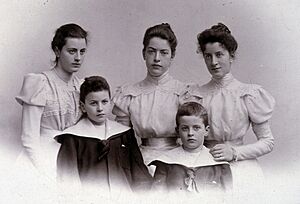Paul Wittgenstein facts for kids
Quick facts for kids
Paul Wittgenstein
|
|
|---|---|

Paul Wittgenstein playing the piano
|
|
| Background information | |
| Born | November 5, 1887 Vienna, Austria-Hungary |
| Died | March 3, 1961 (aged 73) New York City, US |
| Occupation(s) | Musician |
| Instruments | Piano |
Paul Wittgenstein (born November 5, 1887 – died March 3, 1961) was an amazing Austrian-American piano player. He became famous for playing the piano with only his left hand. This was because he lost his right arm during World War I. He even asked famous composers to write new music just for him! Paul also figured out new ways to play difficult piano parts using special foot pedals and hand movements. He was the older brother of a famous thinker named Ludwig Wittgenstein.
Contents
Early Life and Music
Paul Wittgenstein was born in Vienna, Austria. He was the fourth son of a wealthy businessman named Karl Wittgenstein. His family home was often visited by famous musicians like Johannes Brahms and Gustav Mahler. Paul even played duets with Richard Strauss when he was young.
He studied piano with well-known teachers. Paul played his first public concert in 1913 and received good reviews. However, the next year, World War I began. Paul joined the army and was shot in his right arm. He was captured by Russian soldiers. Sadly, his right arm had to be removed.
A New Way to Play Piano
While recovering in a prison camp, Paul decided he would still be a pianist. He would just play with his left hand! He wrote to his old teacher, Josef Labor, asking for a piano piece for only the left hand. Labor quickly started writing one for him.
After the war, Paul practiced very hard. He arranged many songs for his left hand. He also learned the new music Labor wrote for him. Soon, he started giving concerts again. People were amazed by his skill, even with only one arm.
Composers Write for Paul
Paul then asked other famous composers to write new music for him. Many agreed, including Benjamin Britten, Paul Hindemith, Sergei Prokofiev, and Richard Strauss.
The most famous piece written for him was the Piano Concerto for the Left Hand by Maurice Ravel. However, Paul made some changes to the music before playing it. Ravel was very upset, and they never became friends again.
Paul didn't play every piece written for him. He told Prokofiev that he didn't understand his 4th Piano Concerto. He said he would play it someday, but he never did. He also didn't like a piece by Hindemith. He hid the music, and it wasn't found until after his wife died many years later.
Paul could do this because his contracts said he had the only right to perform the music during his lifetime. He explained that he paid for these works, so they should be his to perform. Once he stopped playing concerts or passed away, the music would be available for everyone.
Paul's Legacy
Many of the pieces Paul commissioned are still played today. Other pianists who lost the use of their right hands, like Leon Fleisher, have also played these special works.
Paul's playing style changed over time. Some people said his playing became "harsh." He also sometimes changed the music without the composer's permission. This made his musical reputation a bit controversial.
Moving to America
Paul's family had converted to Christianity many years before he was born. However, under the Nazi Party rules, they were still considered Jewish. When the Nazis took over Austria, Paul tried to convince his older sisters to leave Vienna. But they loved their home and didn't think they were in danger.
Paul himself was no longer allowed to perform in public under the Nazis. So, he moved to the United States in 1938. From there, he and his sister Margaret worked to help their other sisters. They used their family's money and legal connections to get their sisters special non-Jewish status. This allowed them to stay in their family palace in Vienna.
Paul's family had a very large fortune. They gave up most of their money and property to the Nazis. This was done to protect his two sisters.
Personal Life
Paul married his piano student, Hilde. They had two children before they got married. In 1938, Paul went to New York. In 1940, he spent time in Cuba to get visas for Hilde and himself. They got married in Havana in a Catholic ceremony.
When his wife and children arrived in the United States in 1941, he set them up in a house on Long Island. Paul became an American citizen in 1946. He spent the rest of his life in the United States, teaching and playing music. He passed away in New York City in 1961.
Art Collector
Paul Wittgenstein also loved collecting art. He owned artworks by artists from the Vienna Secession, especially Gustav Klimt. He also had a large collection of music and musical instruments.
Images for kids
See also
 In Spanish: Paul Wittgenstein para niños
In Spanish: Paul Wittgenstein para niños



